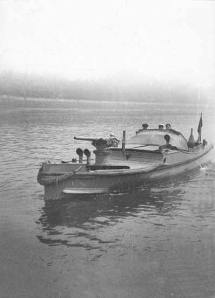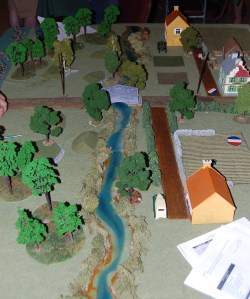Williamsburg Legati plan on commemorating the 100 year anniversary of the Great War by sponsoring several games at the local conventions (Williamsburg Muster and Guns of August) as well as Historicon. With this in mind a number of different scenarios representing the different fronts, different scales of miniatures, and different scales of conflict have been agreed upon. One rather interesting conflict that has been chosen has been the little known Battle of Lake Tanganyika.
Germany’s wealthiest African possession at the beginning of World War One was German East Africa, but the war threatened the Hun’s hold on the place. Surrounded by the colonies of her enemies, the Belgians, Brits, and Portuguese, German East Africa only had contact to the outside world through the Indian Ocean. Most of its Western border with Belgian Congo was marked by Lake Tanganyika.
Lake Tanganyika is one of Africa’s great lakes. It is the longest freshwater lake and the world, as well as the second deepest and second in volume of water. It empties through the Congo river system into the Atlantic. Lake Tanganyika varies between 20-40 miles east to west and 420 miles long north to south. Naval superiority of the Lake was crucial.
At the War’s start only a handful of powered vessels could be found on the Lake. These were small, mostly steam driven vessels engaged in various commercial activities. Most of them were shipped in pieces from wherever they were built and reassembled upon arrival at the Lake.
The largest of these was the Alexandre Delcommune. In August of 1914 this 90 ton Belgian steamer founder herself uncomfortably birthed in the German held port of Kigoma. Due to confusion regarding the neutrality of the Belgian Congo the Germans allowed her to leave on the 6th
 Alexandre Delcommune
Alexandre Delcommune
Worried by British Naval attacks at DaresSalaam and by a shortage of fuel, the Germans scuttled the ship Moewe which had been ordered to raid commerce in that vicinity. 30 of her crewman under the command of Captain Horn went to Kigoma to destroy the Alexandre Delcommune.
Horn took a commercial vessel the Hedwig von Wissman armed her 4 37mm pom pom guns salvaged from the ill fated Moewe and began to patrol the Lake.
Hedwig von Wissman
Some debate remains over who fired the first shots on the Lake, but on August 22 the Hedwig fired upon the Delcommune damaging her boiler and stack and forcing her crew to ground her to prevent a complete loss. Control of the Lake was now firmly in the hands of the Germans.
Paul von Lettow-Vorbeck ordered the remaining crew and the Moewe‘s former Captain Zimmer to take control of the the Lake region. Zimmer made his headquarters at Kigomi do to its rail connections. The German fleet now consisted of the Hedwig von Wissman, the steam launches of the Moewe, a few Schutztruppe and government boats brought from the harbour in Daressalam , including the petrolboat Peter, the motorboat Benz of the German East Africa Railway Company, and most notably the 20 ton patrol boat Kingani.

Kingani
The Hedwig and Kingani as well as a raft carrying the larger guns of the Meowe continue to sink any vessels they find that might be large enough to be armed against them. they are also responsible for a number of raids attempting to finally destroy the Delcommune. Finally several crates holding the parts of the Graf von Goetzen a small 1200 ton ship arrive.

Goetzen
The Force Publique Commandant of the region Commandant Goor calls for aircraft, submarines and torpedo boats to solve his crisis. He receives the Netta. Netta was a motor torpedo boat sent to Tanganyika without torpedos.

Netta
Britain also responds. A professional hunter, African adventurer and poacher John Lee devises a scheme. If two fast petrol boats can be acquired and fitted out with superior weapons, and transported in one piece through the Congo, they can win back the Lake. The idea is communicated to the Admiralty and after consulting with the Belgians, Admiral Sir Henry Jackson approve the plan with the words, “It is both the duty and the tradition of the Royal Navy to engage the enemy wherever there is water to float a ship.” Two forty foot long boats are acquired. Made byt Thorneycroft for the Greek Air Forceto serve as seaplane tenders. Both are fitted with a 3 pounders and a Maxim machine gun aft. Trials on the Thames proved that the 3 pounders were to much for the vessels and would break free or capsize the boats if not fired directly forward!
 One of the two Thornycraft boats
One of the two Thornycraft boats
The trip from the Thames to Albertville was so difficult and unlikely that neither the Belgian Allies or the Germans who learned of the attempt gave it much credence. Remarkably however, carried by a number of different conveyances through many difficult circumstances the boats did after several month arrive. The story of their travel is itself quite an adventure but to lengthy to describe here. A very good account of it may be found in National Geographic Magazine written by a man named McGee who accompanied the expedition, the boats arrive and are on the water by the 23rd of December 1915.
Some mention of the commanding officer of this unlikely “circus” must be made. Lt. Commander Geoffrey Spicer-Simson had so far had far less than a spectacular naval career. An accident in a destroyer caused a collision with a launch that resulted in a death. Another vessel under his command was torpedoed while its Commander was “entertaining Ladies” in a hotel. At the time he was appointed to this expedition he was commanding a desk, responsible for transitioning Merchant Sailors into the Royal Navy. He was by many accounts a lying and arrogant man and developed a penchant for wearing skirts. Spicer-Simson attempted to christen the two motor launches Cat and Dog. The Admiralty flatly refused so instead they were named Mimi and Tou-Tou. Later their commander would admit that the names were simple French Slang for Meow and Bow-wow.

Spicer-Simson semaphoring from the foredeck of the Netta
As mentioned above, the Germans had heard of the intention of the British to bring these boats to Albertville, but they were more concerned with Belgian intentions to assemble the 700 ton Baron Dhanis. After three failed attempts to get close enough to the new harbour at Albertville to investigate, they finally sent Lieutenant Rosenthal ashore to gain intelligence. After failing to meet his rendezvous with the Hedwig he is taken prisoner by the Force Publique.
Rosenthal quickly learns of Mimi and Tou–tou and recognizes tha they are the greater threat than the only partially built Baron Dhanis. The Belgians permit him to write to the German headquarters at Kigoma. Rosenthal writes a secret message on the letter in urine to inform the Germans of the new threat, but the letter is not received and deciphered until far to late.
On December 26th, just three days after the British vessels arrive, the German patrolboat Kingani steams by to again investigate. The Mimi and Toutou with the Netta as a tender race out to meet her. Realizing that the Kingani’s 6 pounder cannot fire to her rear, Spicer-Simpson orders the vessels to stay in her blind zone. the Kingani‘s Captain Lt Junge is killed and all but two of her seven man crew are killed or wounded when she is forced to lower her colours. The Mimi takes her as a prize but not before accidentally ramming her. She sinks in shallow water before being brought safely back to Albertville.
The Germans received intelligence from spies amongst the natives that Kingani was sunk by Belgian shore battery fire. In February reports of increased Belgian naval activity and still not certain of the fate of the Kingani, Zimmer sent the Graf von Goetzon, the Hedwig von Wissman and an unkown small steam boat to investigate. At Kungwestock on the German side of the lake the flotilla divided its courses. the Hedwig was ordered to steam to the report site of the Kingani wreckage and would then reconnoiter with the Goetzen at Lukuga to destroy whatever threat the Belgians had there.
Unbeknownst to the Germans, the British had raised the Kingani, repaired her hole and moved her 6 pounder aft, and installed one of the 12 pounders serving as shore a battery forward. Spicer–Simson renamed her the Fifi which he explained was french for tweet tweet!
On February 9 after failing to find the wreckage of the Kingani, the Hedwig was spotted by the allies. Fifi and Mimi and a Belgian river barge called simply the Dix-tonne, began to pursue. The Toutou was laid up having been damaged. The Hedwig originally steamed directly at them, but then came about and started to run.

Dix-Tonne
Hedwig was slightly faster than Fifi and began to pull away from her but much slower than Mimi. The later very carefully stayed to the rear of Hedwig, avoiding her larger bow gun and staying out of ranger of her aft gun. Hedwig kept tacking in hopes of getting her forward guns to bear and this action allowed the slower Fifi to catch up with the fight. Putting her 12 pounder to work, harassing the fleeing German. Down to her last few shells, Fifi scored a hit on Hedwig’s boiler stopping her in her tracks. Captain Odebrecht ordered her to be scuttled and the crew to abandon ship, who were then picked up by the British.
Lt Commander Spicer-Simson found a German ensign floating in the wreckage and by doing so is credited with capturing the first one of the war.
Upon learning of the loss of the Hedwig, Zimmer requested that the Kingani‘s sister ship Wami and the Adjutant be transferred to Lake Tanganyika. This request was honoured, but neither of them would see action. Fearing land action, Zimmer also reinforced the defenses at Kigoma which included removing all but one pom pom gun from the Goetzen .

Adjutant
Spicer-Simon proved unwilling to confront the larger Graf von Groetzen, and instead began to apply himself to supporting land actions. A stalemate began with Spicer-Simson refusing to enter into offensive actions and Zimmer unable to. The Germans began to place more importance upon their land war and finally in July Paul von Lettow-Vorbeck ordered Zimmer to pull back from Kigoma. Goetzen unable to retreat or defend herself was scuttled. She would later be raised by the British and continues to ply her trade as the Liemba, the last reminder of the days of Spicer-Simpson’s circus.
 MV Liemba
MV Liemba
May 7, 2013
Categories: Boilers and Breechloaders, Convention, Naval, World War One . Tags: battle of lake tanganyika, german east africa, tanganyika lake . Author: fusilier55 . Comments: Leave a comment
 The club participated as we always do in another Williamsburg Muster. Though this one was different in a number of ways.
The club participated as we always do in another Williamsburg Muster. Though this one was different in a number of ways.
































